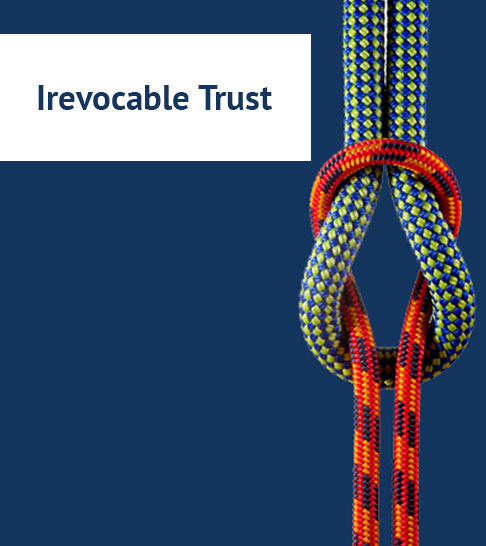|
Revocable Trusts |
Irrevocable Trusts |
|
Assets are considered owned by the grantor |
Assets are no longer owned by the grantor |
|
Change trust document as desired |
Difficult or impossible to amend trust |
|
Can change the trustee |
Can’t change the trustee or beneficiary |
|
Avoids probate court |
Avoids probate court |
|
Trust assets are protected |
|
|
Beneficiaries pays income taxes |
The difference between Revocable Trusts and Irrevocable Trusts
All living trusts can be revocable or irrevocable. A living trust is created while the person who makes the trust is alive. As the names may suggest, the main difference is in the amount of the control the grantor has after making the trust. This is just the beginning however, as there are several major differences between the two. In this article we will discuss the differences, as well as the advantages and disadvantages of each type of trust.
What is a Revocable Trust?
With a revocable trust, income earned by the trust is distributed back to the grantor, and only after the grantor passes away do the trust assets transfer to the beneficiaries.
Simply stated, a revocable living trust can be changed or revoked by the grantor at any time. The grantor can modify the trust using an amendment if they decide to change who should be the beneficiary or the successor trustee. The grantor can also revoke or undo the entire trust if they would prefer a completely new document or to leave the assets outside of trust. Generally, the grantor of a revocable trust personally acts as trustee, managing its assets, after the trust is formed and funded. While this level of control is beneficial, it does have certain drawbacks which means revocable trusts are not ideal in all situations.
One issue with revocable trusts is that any assets held in trust are still considered personal property of the grantor, because they continue to have absolute control. Unfortunately, this means that trust assets in a revocable trust are not protected from creditors or in the event of a lawsuit. Additionally, for Medicaid planning purposes, any assets held in a revocable trust are still considered as owned by the applicant. Under the law, it is as if the trust assets were held personally by the grantor.
Purpose of a Revocable Trust
A revocable trust allows the grantor to avoid probate on any assets held in trust. Although the assets would still be considered for estate tax purposes, they would pass directly to the trust beneficiaries without going through the probate courts. Since probate can be a costly and lengthy process, sidestepping probate is often reason enough to consider a revocable trust.
An added benefit of avoiding probate is that the trust documents remain private, which protects the privacy of any property and beneficiaries after the grantor passes away. The trust does not get filed with the probate court and becomes public record like a Last Will and Testament.
Revocable trusts also allow the grantor to plan for incapacity or mental disability. If the grantor becomes incapacitated, trust assets can be managed by a successor trustee designated ahead of time. Otherwise, a third party would need to petition the courts in a conservatorship proceeding in order to manage someone else’s property. The trust document can include specific instructions for how to administer and use the trust assets according to the grantor’s wishes.
A revocable trust is beneficial for someone who is not concerned about a potential estate tax liability, wants to plan for succession, wants flexibility and control over his or her assets, and wants to protect the beneficiaries’ inheritance from creditors, lawsuits, or other legal threats.
What Is an Irrevocable Trust?
Generally, assets placed in an irrevocable trust is considered as a completed gift to the beneficiaries. An irrevocable trust can’t be modified by the grantor alone once the agreement has been signed.
Much like a revocable trust, assets placed in an irrevocable trust will also avoid probate, and will also help in case of incapacity as a trustee and successor trustee is nominated in the trust. An irrevocable trust also has the advantages of providing a degree of asset protection during the grantor’s lifetime and can be used for estate tax planning and Medicaid planning purposes. Unlike a revocable trust, however, the grantor no longer has the same level of flexibility and control over the trust assets.
Purpose of an Irrevocable Trust
Irrevocable trusts can take on many forms and can be used to accomplish a variety of estate planning goals. While the grantor is forced to give up control of the trust assets, there are often several good reasons to do it. One of the main benefits afforded by irrevocable trusts is that they can provide asset protection not just for the beneficiaries, but for the grantor during his or her lifetime. An irrevocable trust can be used to remove valuable assets out of the direct control of the grantor and under the control of a third-party trustee, making them harder to access in case of a lawsuit. With a specialized irrevocable asset protection trust, assets can even be moved offshore and out of reach of the U.S. court system. This makes irrevocable trusts an incredible solution for anyone who is concerned about potentially being the victim of a lawsuit.
Irrevocable trusts can take assets out of the estate during the grantor’s lifetime if there is a concern about the estate tax. Since the assets placed in an irrevocable trust are no longer owned by the grantor, they are not included in the value of the estate.
For the same reason, certain irrevocable trusts can also be used to qualify for government assistance such as Medicaid. Since this government programs have very strict income and asset level requirements, transferring property to an irrevocable trust well in advance can help meet the government requirements.
What type of trust is best for you?
Whether you need a revocable or an irrevocable trust, or if you would like to learn more about what would work best for your particular situation, Blake Harris Law can help. We have helped thousands of clients over the years use trusts to plan for their succession, protect their assets, apply for Medicaid, and more. Use the questions below as a guideline to help determine whether you could benefit more from a revocable or irrevocable trust.
1. Are you trying to avoid probate?
If you would like to avoid probate, you can use either a revocable or irrevocable trust. If this is your principal goal you might want to consider a revocable trust since it allows more flexibility and control during your lifetime.
2. Do you want to have the option to change your trustee or beneficiaries?
If you want to have the option to change who manages or property or who receives your assets after you pass away, a revocable trust would be the best fit. With an irrevocable trust, these changes would be more difficult to complete.
3. Are you concerned about being the victim of a lawsuit?
Certain professions such as those in the medical field, real estate industry, or business owners are particularly at risk. If you want to protect yourself and your family from a lawsuit, an irrevocable trust may be the best option.
4. Do you want to be eligible for Medicaid or Social Security Disability?
If you are over the asset or income limitations, an irrevocable trust can help you meet the government requirements. If you are planning on gifting your assets to your family or other loved ones in order to qualify, an irrevocable trust can help you keep a bit of control over the assets you give away.
5. Are you concerned about estate taxes?
The estate and gift tax exemption for 2020 is $11.58 million per individual, if your estate is over this threshold setting up an irrevocable trust could help lower the tax liability of your estate.





